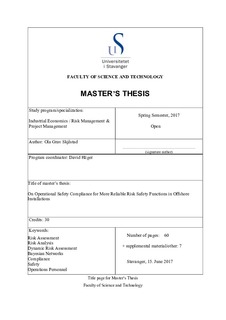| dc.contributor.advisor | Häger, David | |
| dc.contributor.author | Skjåstad, Ola Grav | |
| dc.date.accessioned | 2017-09-22T11:47:51Z | |
| dc.date.available | 2017-09-22T11:47:51Z | |
| dc.date.issued | 2017-06-13 | |
| dc.identifier.uri | http://hdl.handle.net/11250/2456273 | |
| dc.description | Master's thesis in Industrial economics | nb_NO |
| dc.description.abstract | Due to a recent increase in major accident risk, efforts are being made to improve the robustness of the safety functions of offshore installations. Based on how the safety functions are defined and structured, their reliability is heavily dependent on the performance of the operations personnel. The robustness of the safety functions is based on the assumption that the personnel will behave according to policies and procedures and not commit errors or make mistakes accidentally or intentionally. Since risk assessment is the support for decisions made during the planning phase of an operation, it is likely that it can also be utilized to provide similar decision support to the safety functions during the actual operation.
This thesis explores how the risk assessment can be used to better ensure the operational compliance and safe behavior of personnel in order to implement and maintain the safety functions that make up robust design and barriers. This is done by evaluating underlying factors for major accidents and the risk assessment process to determine what causes non-compliance and unsafe behavior.
The aggregated effect of non-compliance and unsafe behavior is one of the leading causes of major accidents. This is most likely related to the lack of understanding and awareness as people have not been given sufficient information to consider and/or be made aware of potential consequences of their actions. Relevant information that is generated in the risk assessments is not easily accessible as it is stored within numerous static comprehensive reports and based on tools that cannot include new emergent information during the operation.
Dynamic Risk Assessment (DRA) using dynamic Bayesian Networks provide relevant and timely decision support by representing a live overview of cause & effect relationships with conditional probabilities. This could allow for detection of abnormalities caused by non-compliance and unsafe behavior and also increase awareness of consequences of non-compliance and unsafe behavior. This is likely to reduce the risk of major accidents. However, further research is required for more conclusive findings. | nb_NO |
| dc.language.iso | eng | nb_NO |
| dc.publisher | University of Stavanger, Norway | nb_NO |
| dc.relation.ispartofseries | Masteroppgave/UIS-TN-IØRP/2017; | |
| dc.rights | Navngivelse 4.0 Internasjonal | * |
| dc.rights.uri | http://creativecommons.org/licenses/by/4.0/deed.no | * |
| dc.subject | industriell økonomi | nb_NO |
| dc.subject | risikostyring | nb_NO |
| dc.subject | prosjektledelse | nb_NO |
| dc.subject | risikoanalyse | nb_NO |
| dc.title | On Operational Safety Compliance for More Reliable Risk Safety Functions In Offshore Installations | nb_NO |
| dc.type | Master thesis | nb_NO |
| dc.subject.nsi | VDP::Samfunnsvitenskap: 200::Økonomi: 210 | nb_NO |

